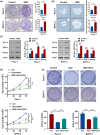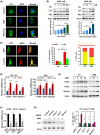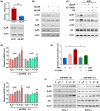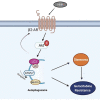NNK from tobacco smoking enhances pancreatic cancer cell stemness and chemoresistance by creating a β2AR-Akt feedback loop that activates autophagy
- PMID: 35593085
- PMCID: PMC9348597
- DOI: 10.1002/1878-0261.13230
NNK from tobacco smoking enhances pancreatic cancer cell stemness and chemoresistance by creating a β2AR-Akt feedback loop that activates autophagy
Abstract
Low responsiveness to chemotherapy is an important cause of poor prognosis in pancreatic cancer. Smoking is a high-risk factor for pancreatic cancer and cancer resistance to gemcitabine; however, the underlying mechanisms remain unclear. 4-(methylnitrosamino)-1-(3-pyridyl)-1-butanone (NNK) is the main metabolite of tobacco burning and has been shown to be associated with cancer development and chemoresistance. However, in pancreatic cancer, its mechanism remains poorly understood. In this study, we found that NNK promoted stemness and gemcitabine resistance in pancreatic cancer cell lines. Moreover, NNK increased autophagy and elevated the expression levels of the autophagy-related markers autophagy-related gene 5 (ATG5), autophagy-related gene 7 (ATG7), and Beclin1. Furthermore, the results showed that NNK-promoted stemness and gemcitabine resistance was partially dependent on the role of NNK in cell autophagy, which is mediated by the β2-adrenergic receptor (β2AR)-Akt axis. Finally, we proved that NNK intervention could not only activate β2AR, but also increase its expression, making β2AR and Akt form a feedback loop. Overall, these findings show that the NNK-induced β2AR-Akt feedback loop promotes stemness and gemcitabine resistance in pancreatic cancer cells.
Keywords: NNK; autophagy; chemoresistance; pancreatic cancer; stemness.
© 2022 The Authors. Molecular Oncology published by John Wiley & Sons Ltd on behalf of Federation of European Biochemical Societies.
Conflict of interest statement
The authors declare no conflicts of interest.
Figures






Similar articles
-
β2-adrenogenic signaling regulates NNK-induced pancreatic cancer progression via upregulation of HIF-1α.Oncotarget. 2016 Apr 5;7(14):17760-72. doi: 10.18632/oncotarget.5677. Oncotarget. 2016. PMID: 26497365 Free PMC article.
-
4-Methylnitrosamino-1-3-pyridyl-1-butanone (NNK) promotes lung cancer cell survival by stimulating thromboxane A2 and its receptor.Oncogene. 2011 Jan 6;30(1):106-16. doi: 10.1038/onc.2010.390. Epub 2010 Sep 6. Oncogene. 2011. PMID: 20818420
-
Akt kinase mediates the prosurvival effect of smoking compounds in pancreatic ductal cells.Pancreas. 2013 May;42(4):655-62. doi: 10.1097/MPA.0b013e3182762928. Pancreas. 2013. PMID: 23271397 Free PMC article.
-
Tobacco carcinogen NNK-induced lung cancer animal models and associated carcinogenic mechanisms.Acta Biochim Biophys Sin (Shanghai). 2015 Jul;47(7):477-87. doi: 10.1093/abbs/gmv041. Epub 2015 Jun 3. Acta Biochim Biophys Sin (Shanghai). 2015. PMID: 26040315 Review.
-
Recent studies on mechanisms of bioactivation and detoxification of 4-(methylnitrosamino)-1-(3-pyridyl)-1-butanone (NNK), a tobacco-specific lung carcinogen.Crit Rev Toxicol. 1996;26(2):163-81. doi: 10.3109/10408449609017929. Crit Rev Toxicol. 1996. PMID: 8688159 Review.
Cited by
-
Epidemiology of pancreatic cancer: New version, new vision.Chin J Cancer Res. 2023 Oct 30;35(5):438-450. doi: 10.21147/j.issn.1000-9604.2023.05.03. Chin J Cancer Res. 2023. PMID: 37969957 Free PMC article.
-
Crosstalk Between Peripheral Innervation and Pancreatic Ductal Adenocarcinoma.Neurosci Bull. 2023 Nov;39(11):1717-1731. doi: 10.1007/s12264-023-01082-1. Epub 2023 Jun 22. Neurosci Bull. 2023. PMID: 37347365 Free PMC article. Review.
-
Downregulation of the phosphatase PHLPP1 contributes to NNK-induced malignant transformation of human bronchial epithelial cells (HBECs).J Biol Chem. 2025 Mar;301(3):108221. doi: 10.1016/j.jbc.2025.108221. Epub 2025 Jan 23. J Biol Chem. 2025. PMID: 39863100 Free PMC article.
-
PI3K/AKT Immunoexpression Influences the Prognostic Factors of Patients Diagnosed with Oropharyngeal Squamous Cell Carcinoma.Asian Pac J Cancer Prev. 2024 Nov 1;25(11):3807-3815. doi: 10.31557/APJCP.2024.25.11.3807. Asian Pac J Cancer Prev. 2024. PMID: 39611903 Free PMC article.
-
Tobacco carcinogen NNK promotes pancreatic cancer proliferation via LINC00857/β-catenin.Tob Induc Dis. 2025 Apr 29;23. doi: 10.18332/tid/203455. eCollection 2025. Tob Induc Dis. 2025. PMID: 40303426 Free PMC article.
References
Publication types
MeSH terms
Substances
LinkOut - more resources
Full Text Sources
Medical

